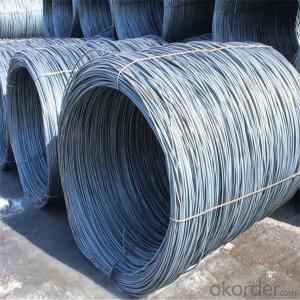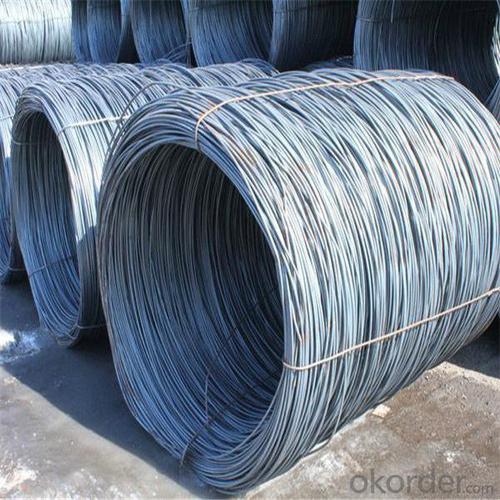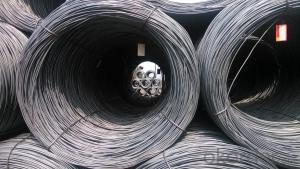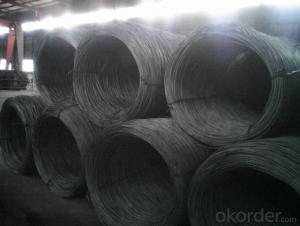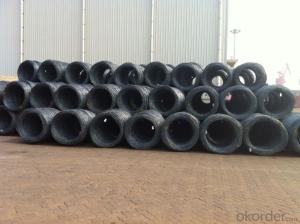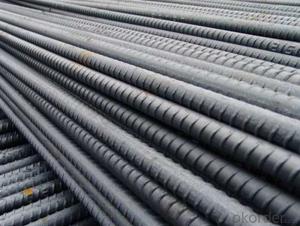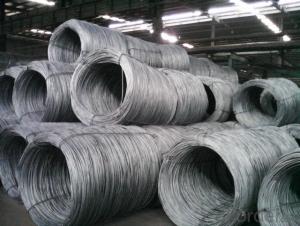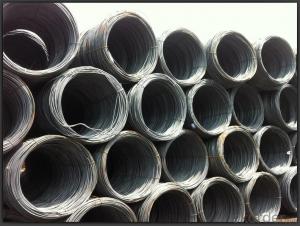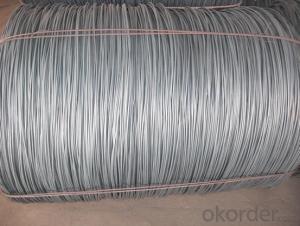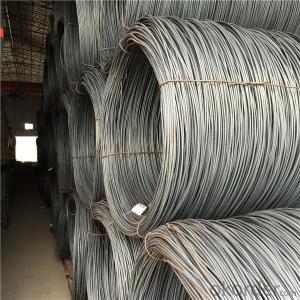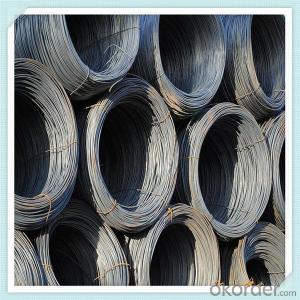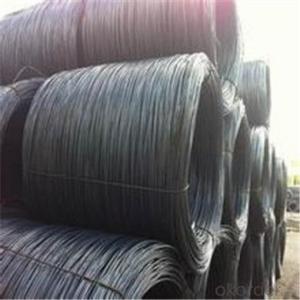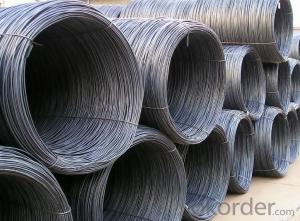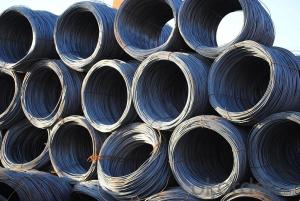Steel wire rod hot sale 5.5-14mm from mill directly
- Loading Port:
- China main port
- Payment Terms:
- TT OR LC
- Min Order Qty:
- 50 m.t.
- Supply Capability:
- 16532 m.t./month
OKorder Service Pledge
OKorder Financial Service
You Might Also Like
Specification
Produced from billets at the rolling mill, wire rod is the basis of all steel wire, rope and fencing products.
The most important characteristic in determining wire rod’s end use is its drawability. Common low carbon
wire rod is used for nails, small shaped products, barbed wires, various wire nettings, steel chains, and other
applications. High Carbon wire rod uses include steel tire cords for automobiles, conveyor belts, and pressure
hoses. Other applications include bolts, nuts, and machine parts, as well as compression, tension and torsion springs.
Our Advantage: High quality steel products from 1 class mills in
Reasonable price
Professionalism of the products
On-time delivery
Complete documents and certificates
Sincere service to meet our clients' requirements
Product Description :
Standard | AISI, ASTM, BS, DIN, GB, JIS |
Material/steel grade | Q195-Q235,SAE1006B,SAE1006CR, SAE1008B, SAE1008CR, SAE1010B, SAE1018B, or according to customers requirements |
Wire Gauge | 5.5-12mm |
Coil weight | 1.8-2.1mts |
MOQ | 25MT |
Delivery Time | 15-30 days after receipt of L/C or deposit by T/T |
Packing | In coil and load in container, if large quantity, by bulk vessel; Can be packed as customers' special requirements |
Payment terms | 1).100% irrevocable L/C at sight. 2).30% T/T prepaid and the balance against the copy of B/L. 3).30% T/T prepaid and the balance against L/C |
Application | widely used in machinery parts, manufacturing industry, electronics industry, metal tools and others |
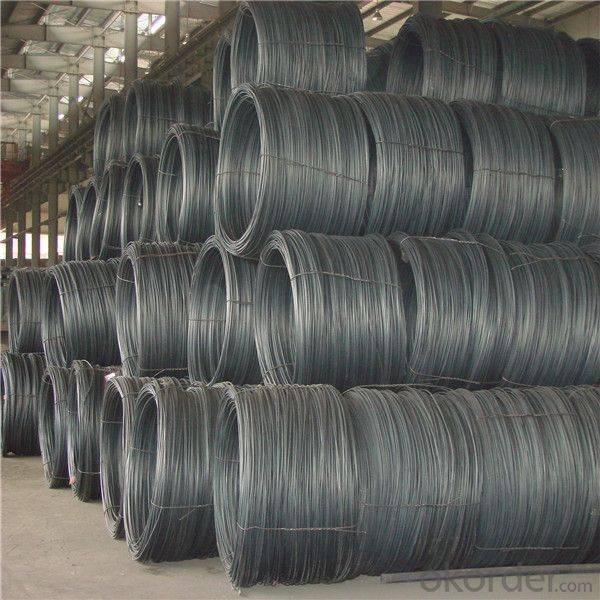
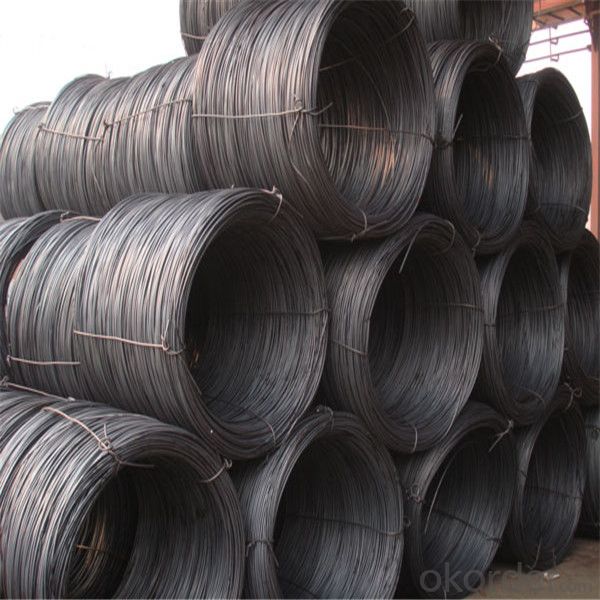
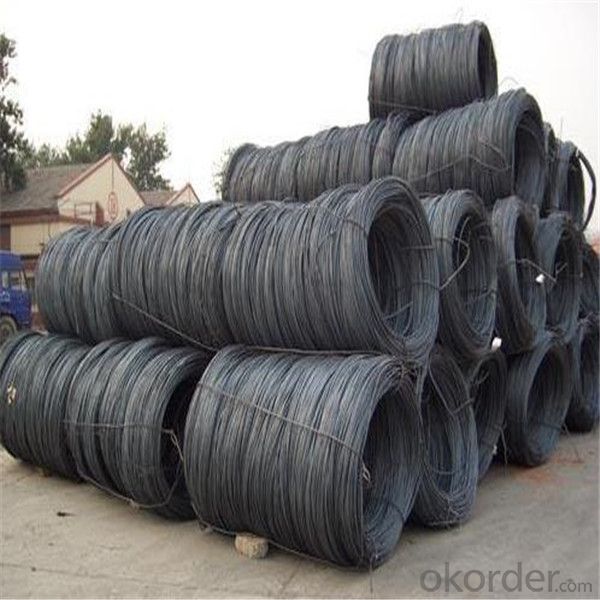
Application :
It generally used in braiding the hose for bathing product and machinery. With it
good flexibility, resistant to high temperature and resistant to corrosion, it
used widely in many industries.
Packing :
Hot-rolled wire rod is held in a unit with at least four steel straps in the
transverse direction and transported and stored without further packaging.
Before
the steel strapping is applied, the wire rod must be sufficiently compressed.
The strapping is fixed in the transverse direction with a single circumferential
strap so that the strapping does not slip and cause the coil to come apart.
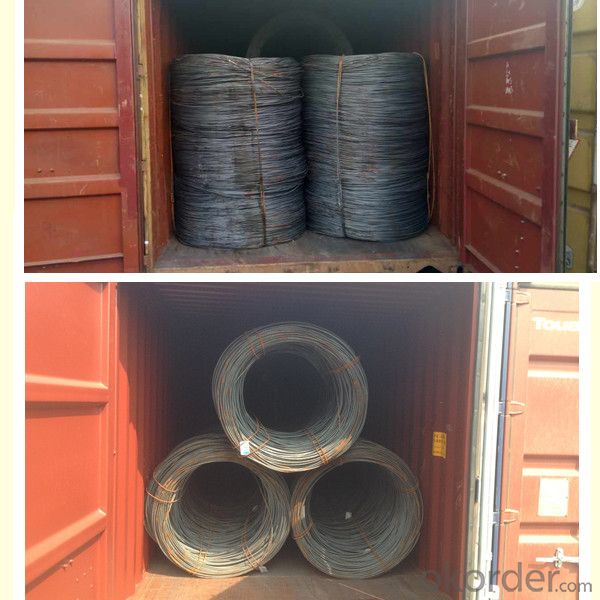
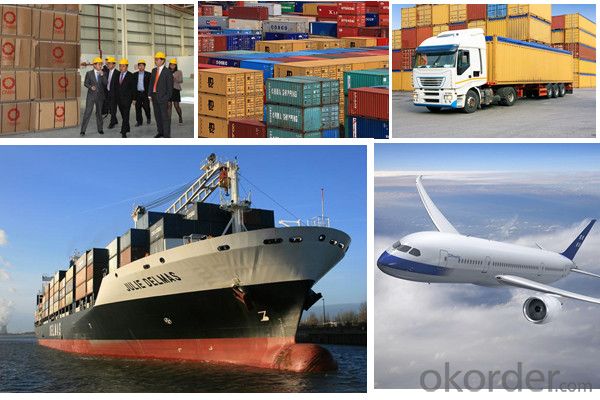
Our service:
(1) We cooperate with famous factories with advanced equipment and well trained workers.
(2) We can provide factory price with trading company service.
(3) We continuously work on the improvement of our processes, guaranteeing
consistently high standards of quality to keep none compensation.
(4) We guarantee 24 hours response and 48 hours solution providing service.
(5) We accept small order quantity before formal cooperation.
(6) We deliver the agreed quality at the agreed time, reacting to changes in
customer wishes in a flexible way.
(7) Due to our volume and selling power, we have excellent freight rates with
shipping lines.
(8) We strive to always be fair and honest in our dealings with customers.
(9) We strive to work together with customers to achieve much more than we can
achieve alone.
(10) Through our passion and commitment we aim to be a market leader in all our
key markets. To maintain our position as market leader we must continue to add
value in all that we do.
FAQ:
1.Q: What's your MOQ(minimum order quantity)?
A: One full container, mixed acceptable .
2. Q: What's your packing methods?
A: Packed in bundle or bulk ..
3. Q: How can I buy CNBM products in my country?
A:Please send us an inquiry or email ,we will reply to you if there is distributor in your country
4. Q: Can we visit your factory?
A: Warmly welcome. Once we have your schedule, we will arrange the
professional sales team to follow up your case.
5. Q: How long does it take to get the product if i place an order?
A:With the process of your requirements,we will pack and deliver in 3
-7 days. If it is by sea shipment,it will take 15-45 days depending on different locations
- Q: What are the main factors influencing the choice of steel wire rod storage conditions?
- The main factors influencing the choice of steel wire rod storage conditions include the type and quality of the wire rod, the desired shelf life, the environmental conditions, and the specific requirements of the end-use application.
- Q: How is the fatigue strength of steel wire rod determined?
- The fatigue strength of steel wire rod is established by conducting a series of tests that entail subjecting the material to repetitive cycles of loading and unloading until it fails. This procedure, known as fatigue testing, aids in determining the endurance limit or fatigue strength of the wire rod. Throughout the process of fatigue testing, a sample of the steel wire rod is prepared in accordance with specific standards and guidelines. Typically, the sample takes the form of a specimen with standardized dimensions and shape. The preparation of the sample entails meticulously machining the wire rod to eliminate any surface imperfections or irregularities that could impact the test results. The subsequent step involves subjecting the sample to cyclic loading, wherein the wire rod is repeatedly exposed to a fluctuating load. This can be achieved using specialized testing machines that apply the load in a controlled manner. The load applied during the testing process may either be of constant amplitude or variable amplitude, depending on the specific requirements of the test. The sample is usually loaded with a range of stress amplitudes, commencing from a relatively low value and progressively increasing until failure occurs. The number of cycles until failure is recorded for each stress level, and this data is employed to construct an S-N curve, also known as a fatigue curve. The S-N curve depicts the correlation between the applied stress amplitude and the number of cycles until failure. Through analysis of the S-N curve, engineers can determine the fatigue strength of the steel wire rod. Fatigue strength is generally defined as the stress amplitude at which the material can endure an infinite number of cycles without experiencing failure. This is commonly referred to as the endurance limit. In addition to fatigue testing, other factors such as material composition, surface finish, and environmental conditions can also impact the fatigue strength of steel wire rod. Hence, it is crucial to consider these factors when assessing the fatigue strength of the wire rod for specific applications.
- Q: How is steel wire rod used in automotive applications?
- Steel wire rods are extensively used in automotive applications due to their high strength, durability, and flexibility. They are primarily used in the manufacturing of various automotive components such as springs, cables, tires, and reinforcements. Steel wire rods are also used in seat frames, exhaust systems, and suspension systems, where their excellent tensile strength and resistance to corrosion play a crucial role in ensuring the safety and performance of vehicles. Overall, steel wire rods are an essential material in the automotive industry, contributing to the overall strength, reliability, and functionality of automobiles.
- Q: What are the common production processes for tungsten-coated steel wire rod?
- The common production processes for tungsten-coated steel wire rod typically include wire drawing, cleaning, coating, and heat treatment. Initially, the steel wire rod is drawn through a series of dies to reduce its diameter and improve its surface finish. After the wire drawing process, the wire rod is cleaned to remove any impurities. Then, a layer of tungsten is applied to the surface of the wire rod through various coating techniques such as electroplating or vapor deposition. Finally, the coated wire rod undergoes a heat treatment process to enhance the adhesion between the tungsten coating and the steel wire, resulting in a durable and high-quality product.
- Q: How is steel wire rod tested for yield strength?
- Steel wire rod is typically tested for yield strength using a method called tension testing. In this process, a sample of the wire rod is subjected to an increasing tensile force until it deforms plastically or breaks. The yield strength is then determined by identifying the point at which the material begins to show permanent deformation, indicating its ability to resist loads without permanent distortion.
- Q: What are the safety precautions for handling steel wire rod?
- Some safety precautions for handling steel wire rod include wearing appropriate personal protective equipment such as gloves, safety glasses, and steel-toed boots. It is important to handle the rods with care to avoid injuries, such as cuts or punctures. Additionally, workers should be trained on proper lifting techniques to prevent strains or back injuries. Regular inspections of the rods and equipment should also be conducted to identify any potential hazards or defects.
- Q: What are the advantages of using steel wire rod in marine applications?
- There are several advantages of using steel wire rod in marine applications. Firstly, steel wire rod is highly durable and resistant to corrosion, making it ideal for withstanding the harsh marine environment. Additionally, steel wire rod has high tensile strength, allowing it to bear heavy loads and withstand extreme forces. Moreover, steel wire rod is highly flexible, enabling it to be easily shaped and installed in various marine applications. Lastly, steel wire rod is cost-effective and readily available, making it a practical choice for marine construction projects.
- Q: What are the different surface marking methods for steel wire rod?
- Steel wire rods can be marked using various surface marking methods, each serving the purpose of identifying and providing information about the wire rod. One commonly used method involves hot stamping, which impresses an identification mark onto the surface of the wire rod using a heated stamp. This method is reliable and long-lasting since the mark becomes permanently engraved on the steel's surface. Another technique, inkjet printing, involves using an inkjet printer to directly print the necessary information onto the steel wire rod. This method is speedy and allows for flexibility in marking different types of information. Laser marking is also a popular choice, where a laser beam is utilized to remove or alter the surface material of the wire rod, leaving a permanent mark. This method offers precise and detailed markings. Moreover, embossing or engraving can be utilized to create raised or indented markings on the wire rod's surface. These methods are often employed for branding or decorative purposes, but can also convey important information about the wire rod. Ultimately, the selection of a surface marking method for steel wire rods depends on the manufacturer's specific requirements and preferences. Each method has its own advantages and limitations, necessitating careful consideration to ensure accurate and durable markings on the wire rods.
- Q: What are the common production processes for plutonium-coated steel wire rod?
- The common production processes for plutonium-coated steel wire rod include cleaning and preparing the steel wire, applying a thin layer of plutonium coating using techniques like electroplating or physical vapor deposition, and then ensuring the proper adhesion and quality of the coating through processes like heat treatment and testing.
- Q: How is steel wire rod used in the manufacturing of wire forms for sliding doors?
- The manufacturing of wire forms for sliding doors relies heavily on steel wire rod. It acts as the main material for constructing the framework and structure of the wire forms. To begin with, steel wire rod is chosen for its exceptional tensile strength and durability, making it ideal for withstanding the constant movement and stress experienced by sliding doors. The wire rod undergoes a series of processes, including drawing and annealing, to enhance its mechanical properties and ensure it meets the necessary specifications. Following that, the steel wire rod is shaped into various sizes and shapes based on the specific design and requirements of the wire forms. This can be accomplished through techniques such as bending, cutting, and welding. The wire rod is manipulated to create the required curves, angles, and dimensions needed for constructing the sliding door wire forms. Once the wire forms are shaped, they undergo further processing to enhance their functionality and aesthetics. This may involve surface treatments like galvanizing or coating to provide corrosion resistance and improve the overall appearance of the wire forms. Lastly, the wire forms are assembled and integrated into the sliding door system. They are commonly used to support the door panels, guide the movement of the doors along the tracks, and provide stability and smooth operation. The steel wire rod ensures that the wire forms can endure the weight of the door panels and withstand frequent opening and closing without deforming or failing. In conclusion, steel wire rod plays a crucial role in the manufacturing of wire forms for sliding doors by providing strength, durability, and flexibility. It serves as the foundation of the wire forms, enabling them to function effectively and contribute to the overall performance of sliding doors.
Send your message to us
Steel wire rod hot sale 5.5-14mm from mill directly
- Loading Port:
- China main port
- Payment Terms:
- TT OR LC
- Min Order Qty:
- 50 m.t.
- Supply Capability:
- 16532 m.t./month
OKorder Service Pledge
OKorder Financial Service
Similar products
Hot products
Hot Searches
Related keywords
